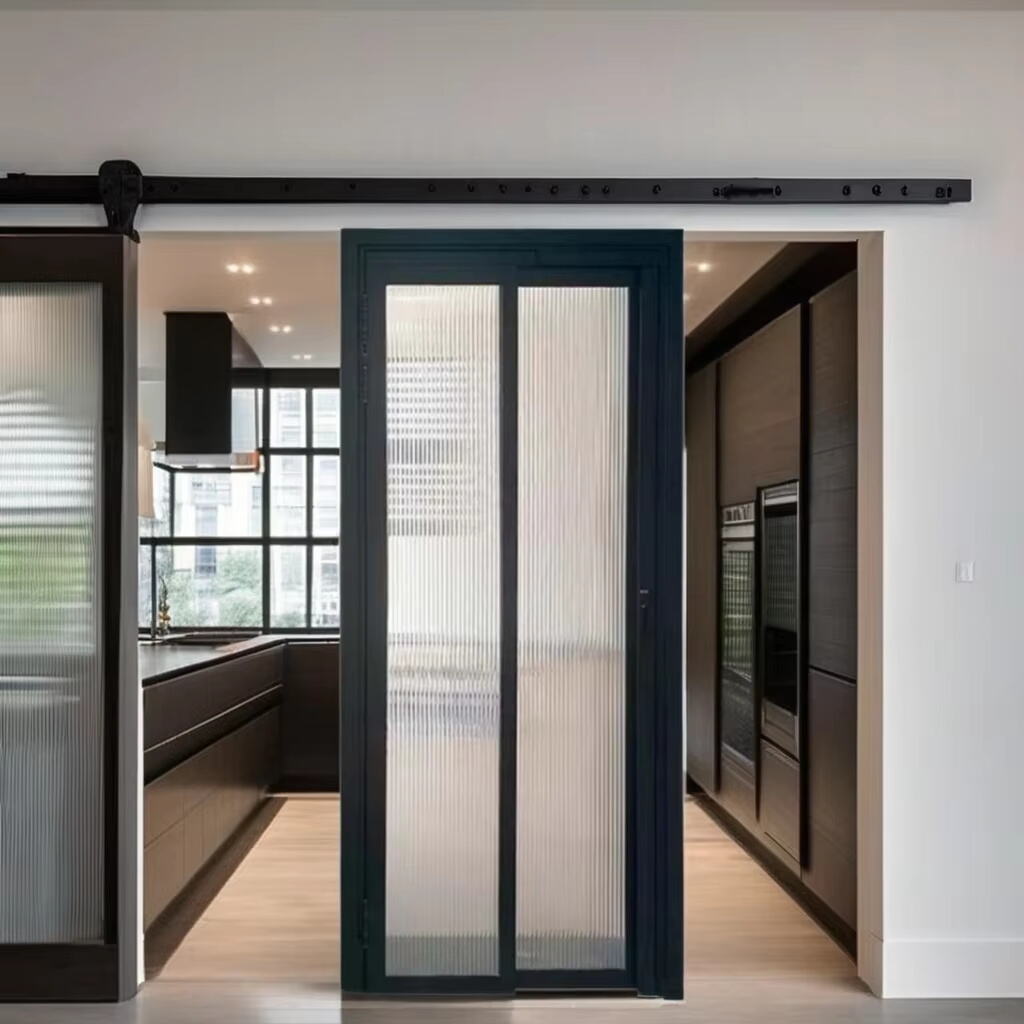Вступ до сучасного Двері Виробництво
Еволюція виробництва дверей
Колись виготовлення дверей було справою майстрів, які вручну обробляли дерево та метал, створюючи вироби, що розповідали історії про місце їхнього походження та потреби людей. З самого початку майстри витрачали години на виготовлення кожної двері, часто передаючи свої техніки з покоління в покоління. Потім настала велика зміна під час промислової революції. Удари машин виробляли двері швидше, ніж хтось міг уявити. Повсюди почали з'являтися фабрики, які випускали однакові двері за частину того часу, який витрачався раніше. Прискоривши події, ми бачили, як у гру вступили ціликом нові технології. Сучасні верстати з комп'ютерним керуванням тепер вирізають матеріали із лазерною точністю, а роботи виконують повторювані завдання. Це означає кращий контроль якості та нижчі ціни для споживачів, які шукають усе — від важких комерційних дверей до елітних побутових моделей. Якщо говорити про цифри, ринок дверей продовжує зростати з року в рік. Експерти передбачають подальший розвиток, оскільки виробники продовжують знаходити нові способи підвищення ефективності та врахування змінних вподобань клієнтів.
Чому інновації визначають сучасні заводи
Сфера виробництва дверей просто не зможе вижити без постійних інновацій у сучасних умовах, якщо компанії прагнуть підвищити ефективність та покращити якість продукції. Розумні технології, такі як IoT-пристрої та сучасні виробничі системи, кардинально змінюють процес виготовлення дверей. Ці інструменти дозволяють виробникам стежити за процесами в режимі реального часу та виправляти проблеми до їх виникнення, що значно підвищує надійність виробництва загалом. Сьогодні клієнти хочуть найрізноманітніших варіантів на замовлення й очікують швидкого виконання замовлень, тому підприємства змушені постійно генерувати нові ідеї. Аналіз даних з кількох виробничих цехів показує, що компанії, які інвестують у нові технології, значно перевершують конкурентів. Підприємства, що впроваджують цифрові рішення, набагато краще справляються з виконанням змінних запитів клієнтів, ніж традиційні цехи, які залишилися в минулих методах у цьому швидкозмінному ринку.
Сировина та компоненти у виробництві дверей
Дерево, метал і скло: основні матеріали, що розкриваються
При виготовленні дверей виробники зазвичай використовують три основні матеріали — дерево, метал і скло, кожен з яких має свої переваги та недоліки. Дерево використовується вже багато століть як улюблений матеріал для дверей. Існують різні види дерева — тверді породи, такі як дуб і клен, які довше служать і мають привабливий вигляд, тому їх часто використовують у будинках преміум-класу, де хочуть чогось особливого. М'які породи дерева, навпаки, дешевші та простіші у виготовленні, що робить їх ідеальними для повсякденного використання в звичайних будинках. Металеві двері, особливо з сталі або алюмінію, забезпечують високу міцність і безпеку. Саме тому їх можна побачити в офісних будівлях, на фабриках та підприємствах, де важливо забезпечити безпеку. Ці метали добре витримують важкі умови експлуатації і навіть краще, ніж багато інших матеріалів, стійкі до вогню. Скло зазвичай не використовується як основний матеріал для дверей, але часто вбудовується в дизайн разом з деревом або металом. Воно додає стиль і дозволяє проникати сонячному світлу, однак при монтажі потрібно проявляти особливу обережність, оскільки розбиття скла може призвести до серйозних проблем, якщо з ним необережно поводитися.
Різні матеріали мають свої переваги та недоліки. Візьмімо, наприклад, дерево — воно чудово виглядає майже в будь-якому оточенні, тому багато дизайнерів люблять з ним працювати. Але є нюанс — дерево схильне до деформації з часом, якщо за ним не доглядати належним чином. Метали, у свою чергу, забезпечують високу міцність і функції безпеки, що робить їх ідеальними для зон з інтенсивним рухом. Проте металеві поверхні з часом можуть іржавіти, якщо їх не покрити або не обробити відповідним чином. Скло додає сучасного, елегантного вигляду, який зараз бажають багато клієнтів, хоча воно коштує дорожче і потребує особливого підходу під час встановлення. Ми помітили зростання попиту на екологічно чисті альтернативи. Вироби з бамбука і скловолокна стають дедалі популярнішими серед споживачів, що турбуються про навколишнє середовище. Хоча традиційні матеріали досі займають основну частку ринку, цей 'зелений' рух, схоже, набирає обертів у різних галузях індустрії.
Отримання та підготовка преміум вхідних даних
При виготовленні дверей преміум-класу важливо використовувати якісні матеріали. Виробникам дверей потрібні надійні постачальники, яким можна довіряти, а також регулярні перевірки для забезпечення стабільності характеристик від партії до партії. Проте останнім часом ми спостерігаємо цікаву тенденцію — все більше компаній звертаються до екологічно чистих рішень. Відновлене дерево стало популярним, тому що допомагає захищати планету, водночас задовольняючи вимоги клієнтів, які обирають екологічно чисті варіанти. Співпраця з постачальниками, які турбуються про походження своїх матеріалів, тепер вже не просто розумний бізнес-підхід. Це стає необхідним, адже споживачі все більше уваги приділяють способу виробництва продуктів. Крім того, такі партнерства часто призводять до кращих довгострокових відносин і можуть допомогти заощадити кошти в майбутньому.
Підготовка матеріалів для виробництва включає правильне підсушування деревини, щоб запобігти її деформації, та нанесення покриттів на метали для захисту від іржі. Якщо ці підготовчі кроки виконані як слід, продукти служать довше й краще виконують свої функції з плином часу. Компанії, такі як Therma-Tru, вирізняються тим, що серйозно ставляться до якості матеріалів і до їхнього походження. Ці підприємства демонструють, чого можна досягти, коли сталість стає частиною повсякденних операцій. Вони знаходять творчі способи повторного використання обрізків і залишків, скорочуючи відходи без погіршення якості виготовленої продукції. Оскільки все більше людей починає турбуватися про екологічний вплив, виробникам потрібно приділяти більше уваги тому, що саме використовується у продуктах, і як обробляються їхні компоненти перед складанням.
Процес виготовлення дверей: крок за кроком
Сучасна CNC обробка та формування
Впровадження технології числового програмного управління (CNC) повністю змінило сучасні методи виготовлення дверей. Ці машини можуть вирізати дверні компоненти з неймовірною точністю та ефективністю, які раніше були неможливими. Їхня особливість полягає в здатності виконувати складні розрізи, які майже неможливо зробити за допомогою традиційних інструментів. Це значно зменшує кількість відходів матеріалу, що залишаються на підлозі виробничого цеху. І справедливо сказати, ніхто не хоче, щоб якісне дерево йшло у відходи. Рівень деталізації, досягнутий за допомогою цих машин, відкриває безліч можливостей для проектування дверей. Виробники тепер можуть виготовляти все — від простих прямокутних панелей до складних вигнутих форм, які відповідають конкретним побажанням клієнтів або вписуються в унікальні архітектурні простори.
Технологія ЧПК дійсно змінила сучасні способи виготовлення дверей, забезпечивши швидші терміни виробництва та значно вищу точність порівняно з традиційними методами. Деякі майстерні дійсно відзначили зростання випуску продукції на 30% після переходу на системи ЧПК, що допомагає їм встигати виконувати замовлення, які надходять від дом покращувальних магазинів і підрядників. Коли різанням займаються машини, а не робітники вручну, помилки майже виключені. Автоматизований процес означає, що під час виробничих циклів потрібно менше коригувань, що з часом економить і час, і матеріали. Виробники вважають це особливо важливим під час масового виробництва однакових дверей, де найважливіше — це стабільність показників.
Автоматизація лінії збірки у сучасних заводях
Сьогодні фабрики відчули суттєві зрушення в способах виготовлення дверей після впровадження роботів на конвеєрні лінії. Ці машини зменшують витрати компаній на оплату праці, практично усувають помилки, властиві людям, і значно прискорюють процес порівняно з ручною працею. Якщо роботи беруть на себе виконання повторюваних завдань замість людей, кінцевий продукт стає набагато більш однорідним за якістю, а також виготовляється швидше. Більшість виробників вважають, що така організація виробництва дозволяє їм розширювати бізнес, не збільшуючи постійно кількість персоналу для задоволення попиту.
Переваги автоматизації збірних ліній очевидні, але багато хто все ще опирається цим змінам, головним чином через те, що люди хвилюються про втрату робочих місць, а компанії вагаються через початкові витрати на нові технології. З часом, однак, бізнеси почали знаходити способи вирішення цих проблем шляхом перенавчання працівників на інші посади та поступового впровадження машин, замість того, щоб робити це відразу. Дані галузі показують, що автоматизована праця стає все більш поширеною по всьому світу. За деякими оцінками, вже за кілька років очікується приблизно шестивідсоткове зростання використання роботів у виробничих галузях.
Від будування рамки до остаточного покриття поверхні
Виготовлення дверей починається з побудови міцних рам, які формують основу продукту. Ці рами мають бути як слід, щоб усе інше потім правильно встановлювалося. Після виготовлення рам виробники наносять різні види оздоблення. Поширені варіанти включають фарбування, дерев'яні тонери або ламіновані покриття. Мета тут подвійна — зробити двері естетично привабливими, а також захистити їх від пошкоджень від погодних умов і повсякденного зношування. Деякі майстерні спеціалізуються на певних типах оздоблення залежно від побажань клієнтів щодо їхніх домашніх або комерційних приміщень.
Спосіб обробки дверей дійсно впливає на їхній зовнішній вигляд і тривалість використання. Техніки, такі як нанесення ламінату преміум-класу, не лише покращують зовнішній вигляд, а й насправді допомагають захистити від зносу на довгі роки. Більшість виробників дотримуються суворих правил, встановлених організаціями, такими як Американська асоціація виробників архітектурного скла (American Architectural Manufacturers Association) або, скорочено, AAMA. Ці рекомендації чітко визначають, що саме має відбуватися на кожному етапі фінішної обробки, щоб усі учасники процесу розуміли, що вважається високоякісною роботою при виготовленні дверей, які витримують повсякденне використання і не розпадаються через кілька місяців.
Контроль якості у виготовленні дверей
Тестування на стрес для тривалості та безпеки
Випробування дверей у умовах підвищеної напруги залишається важливим етапом для виробників, які хочуть, щоб їхні продукти витримували як повсякденне зношування, так і несподівані навантаження. Виробники проводять різноманітні випробування дверей, включаючи влучання важкими предметами та підвішування вантажів на ручки, щоб перевірити, чи вони зможуть витримати багаторічну експлуатацію. Головний висновок простий — коли двері проходять ці жорсткі випробування, споживачі отримують більш безпечну та довговічну продукцію, яка не тріскається і не деформується через зміни погодних умов або постійне відкривання й закривання. Більшості виробників дверей необхідно отримати сертифікацію від організацій, таких як ANSI в Америці або стандартів EN у Європі, перш ніж вони зможуть продавати свою продукцію. Виходячи з досвіду — двері, які ігнорують ці важливі перевірки, часто виходять з ладу набагато раніше, ніж очікувалося. Ми бачили чимало випадків, коли компаніям доводилося припиняти реалізацію цілих партій, тому що двері починали руйнуватися вже через кілька місяців експлуатації замість років, що негативно впливало як на їхні фінанси, так і на репутацію серед покупців, які прагнуть надійного захисту для свого дому.
Відповідність міжнародним стандартам для перформансу
Виробники дверей значно покладаються на міжнародні стандарти, встановлені такими організаціями, як ISO та ANSI, щоб забезпечити якість на всіх рівнях. Ці стандарти визначають основні характеристики, які повинна мати кожна якісна двері на виході з виробництва. Стійкість до вогню, здатність зменшувати шум та ефективність утримання тепла в будівлях — все це перевіряється відповідно до цих правил. Коли компанії дотримуються цих вимог, вони мають вести детальні записи на кожному етапі виробництва, щоб у будь-який момент можна було з'ясувати, чому певні двері мають саме такі характеристики. Більшість цих правил розробляють самі організації, такі як ISO, а також спеціалізовані установи, як-от Інститут дверей і фурнітури, і саме вони визначають повсякденне функціонування виробничих потужностей. Дотримання цих стандартів гарантує, що двері працюватимуть так, як і було заявлено, і це помітно для клієнтів під час встановлення в приватних будинках чи офісах, де особливо важливою є безпека.
Висновок: Майбутнє виготовлення дверей та надходящі тенденції
Виробництво дверей зараз перебуває на цікавому етапі повороту, де інновації, екологічні практики та якість стають все більш важливими чинниками. За останні роки виробники почали впроваджувати більш чисті методи виробництва та шукати способів зменшення відходів, що допомагає їм відповідати сучасним вимогам споживачів. Перехід до екологічно чистих технологій корисний не лише для природи — це ще й вигідне бізнес-рішення, адже все більше людей шукають двері, виготовлені відповідальним способом. У майбутньому автоматизовані системи та індивідуальні рішення стануть важливішою частиною виробництва дверей, особливо з урахуванням зростання попиту на продукти, які ідеально відповідатимуть потребам кожного домогосподарства, а не загальним стандартам. Для компаній, що прагнуть вижити в умовах змінного ринкового середовища, освоєння нових технологій разом із збереженням основних цінностей у сфері сталого розвитку стане ключовим фактором, який забезпечить їм конкурентоспроможність порівняно з суперниками, що можуть зменшити їхню частку на ринку.
Розділ запитань та відповідей
Які головні досягнення в сучасному виробництві дверей?
Сучасне виробництво дверей отримало значні досягнення, включаючи технологію CNC, автоматизацію, IoT та інтелектуальні системи виробництва, що покращують ефективність та якість продукції.
Які матеріали найчастіше використовуються у виробництві дверей?
Загальні матеріали включають дерево, метал і скло, кожен з яких має окремі якості, придатні для різних застосувань.
Як виробники забезпечують якість та безпеку дверей?
Виробники проводять тестування на напруження та притримуються міжнародних стандартів, таких як ISO та ANSI, щоб гарантувати тривалість та безпеку дверей.
Які можливості персоналізації доступні у виробництві дверей?
Виробництво дверей пропонує персоналізацію у стилі, розмірі та закінченні, що задовольняє як естетичні потреби домашніх користувачів, так і функціональні вимоги комерційних об'єктів.
Як інтегрується стійкість у виробництві дверей?
Виробники впроваджують екологічно чисті матеріали, процеси художнього виробництва та стратегії переробки, щоб зменшити викиди та споживання енергії.

